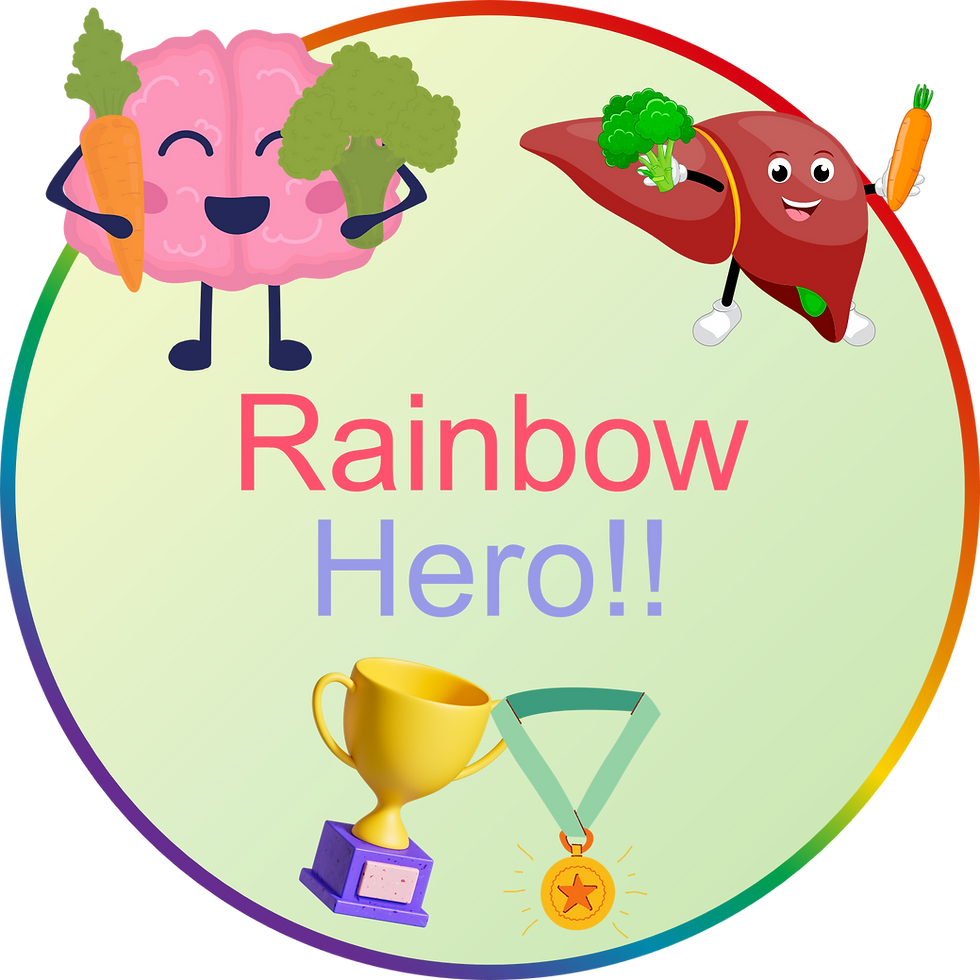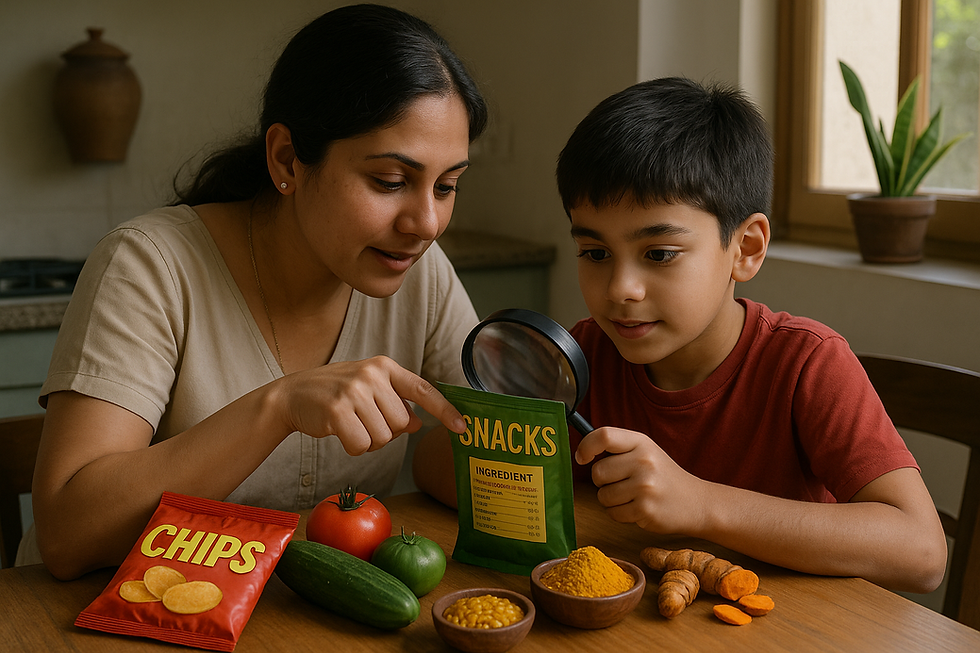Rainbow Diet for Kids: The Complete Guide to Colorful Nutrition for Children
- Dr Tejal Risbud Rao

- May 5
- 5 min read
Updated: May 7

Why Colors Matter on Your Child's Plate
Did you know that only 6% of Indian children eat enough vegetables daily? The solution might be simpler than you think: "eating the rainbow." This approach encourages children to enjoy fruits and vegetables of different colors daily, shifting the focus from serving sizes to exploration and variety.
According to pediatric nutritionist Dr. Tejal Rao, "Children who eat a variety of colorful foods typically receive 90% more essential micronutrients than those with limited color diversity in their diets."
Rainbow Diet Benefits
Each color in fruits and vegetables contains specific nutrients that support different aspects of children's health.
This color guide helps you understand the benefits of each group:
Color Group | Examples | Health Benefits | Kid-Friendly Tips |
Red Foods | Tomatoes, strawberries, watermelon | Support heart health, provide powerful antioxidants | Add strawberries to yogurt, make tomato chutney for parathas |
Orange & Yellow Foods | Carrots, mangoes, sweet potatoes | Promote eye health and vision, boost immunity | Mix grated carrots into roti dough, blend mangoes into lassi |
Green Foods | Spinach, peas, green beans | Build strong bones, provide iron and fiber | Mix spinach into dal, add peas to pulao |
Blue & Purple Foods | Jamun, black grapes, purple cabbage | Support brain function and memory, rich in antioxidants | Make jamun smoothies, prepare purple cabbage salad |
White & Brown Foods | Bananas, cauliflower, and mushrooms | Aid digestion and gut health, provide steady energy | Add banana slices to poha, make aloo gobi |
Age-Appropriate Rainbow Diet
Children's nutritional needs and eating abilities change as they grow. This table helps match appropriate rainbow diet foods to your child's developmental stage:
Age Group | Developmental Stage | Ideal Textures | Rainbow Diet Food Ideas |
1–3 years | Developing chewing skills | Soft, mashed, small pieces | Pumpkin mash, carrot khichdi, banana slices, steamed peas |
4–6 years | More independent eating | Slightly firmer textures, finger foods | Fruit chaat, colorful idlis, vegetable sticks with dips |
7–12 years | Established preferences | Regular textures, mixed foods | Rainbow wraps, layered smoothies, colorful salads |
The Half-Plate Rule
Instead of measuring portions or counting calories, use this visual approach:
Fill half the plate with fruits and vegetables (different colors)
Fill one-quarter with whole grains (multigrain roti, brown rice)
Fill one-quarter with protein (dal, paneer, eggs, yogurt)
This balanced approach ensures children receive a wide spectrum of nutrients without complicated tracking.
Fun Rainbow Diet Ideas
Transform nutrition from a struggle into an adventure by connecting food to what children naturally love—play and discovery:
Create Food Art: Arrange fruits and vegetables to make shapes or patterns on the plate.
Name Game: Give dishes fun names like "Superhero Spinach" or "Rainbow Power Bowl."
Color Challenge: Have a "color of the day" and find foods of that color throughout the day.
Grow Together: Plant colorful vegetables in small pots and let children watch them grow.
Cook Together: Let children help with age-appropriate food preparation tasks.
Rainbow Recipes Kids Love
Rainbow Wrap: Spread hummus on a whole wheat roti, add rows of colorful vegetables like grated carrots, bell peppers, cucumber, and purple cabbage. Roll up and slice.
Fruity Yogurt Bowl: Layer yogurt with diced fruits of different colors. Top with a sprinkle of nuts or seeds for older children.
Colorful Mini Idlis: Add vegetable purees (spinach, beetroot, carrot) to idli batter to create naturally colored idlis.
Rainbow Fruit Skewers: Thread chunks of colorful fruits onto ice cream sticks for a fun snack that children can help create.
Tips for Picky Eaters
Nearly 70% of parents report having at least one picky eater. These evidence-based strategies can help:
Be patient: Children typically need to try a new food 8-10 times before accepting it.
Pair new with familiar: Always serve new foods alongside favorites to build bridges to acceptance.
Keep portions small: Start with just a spoonful of a new food to avoid overwhelming them.
Lead by example: Children are more likely to try foods they see parents enjoying.
No pressure: Keep mealtime positive and pressure-free to enable healthy relationships with food.
Track Rainbow Progress
Create a simple rainbow chart where kids can place stickers for each color of food they try. This visual approach shifts the focus from "eating vegetables" to "collecting colors"—a subtle but powerful reframing that appeals to children's natural desire for achievement.
Fun Food Facts
Children's taste buds are more sensitive than adults, which is why they often prefer milder foods.
The bright color of carrots comes from beta-carotene, which helps children see better, especially at night.
Red bell peppers contain more vitamin C than oranges!
Green leafy vegetables are packed with iron, which helps carry oxygen throughout the body.
Eating a variety of colored foods supports a healthy gut, which research shows is linked to better mood and behavior in children.
Start Your Rainbow Journey
Remember, the goal isn't perfection. Even adding one new color to your child's plate each day makes a difference. Over time, these small changes build healthy eating habits that can last a lifetime.
As pediatrician Dr. Risbud reminds us, "Rainbow eating isn't just about nutrition—it's about creating joy around healthy foods and giving children the gift of good health." Once you've used the rainbow food tracker at the end of this article, don't forget to download our special achievement badge! This colorful reward will motivate your little ones to continue their rainbow eating adventure and celebrate their progress.
Frequently Asked Questions
How many different colors should my child eat each day?
Aim for at least 3-4 different colored fruits and vegetables daily. Start with what's manageable and gradually increase variety.
My child only likes fruits, not vegetables. Is this okay?
While fruits provide many nutrients, vegetables offer unique benefits. Continue offering vegetables alongside favorite fruits, and try serving veggies with dips or incorporating them into smoothies.
Can rainbow eating help with weight management?
Yes! Colorful fruits and vegetables are nutrient-dense but generally low in calories, helping children feel satisfied while maintaining healthy weight.
What if certain colored foods cause allergies?
If your child is allergic to certain foods, focus on safe options within each color group. Consult a nutritionist for personalized guidance on ensuring complete nutrition.
How can I maintain rainbow eating when packing school lunches?
Use bento-style containers with compartments for different colored foods. Prep colorful options on weekends and involve your child in choosing which rainbow diet foods to include.
Does cooking vegetables reduce their nutritional benefits? Some cooking methods can reduce certain nutrients, but light steaming, roasting, or quick stir-frying preserves most benefits while making many vegetables more digestible for children.
This guide was created using information adapted from the National Institute of Nutrition (NIN), India, and UNICEF's Infant and Young Child Feeding Practices.
Earn Your Rainbow Badge! Every color counts toward better health!







Comments